Types of Florida Spiders (with Pictures) – Identification Guide
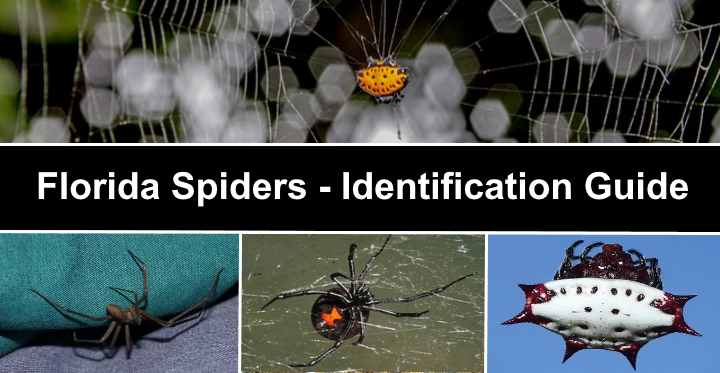
Florida is home to many types of spiders — some are harmless, and some are highly venomous. The two most common venomous spiders in Florida are the brown recluse spider and the black widow spider. But even if a spider doesn’t bite, identifying species of Florida spiders is vital to know what type of arachnid you are dealing with. For example, some brown spiders in Florida are easy to mistake for recluse spiders.
If you live in Florida or just visiting the Sunshine State, it helps to identify various species of spiders. Thanks to Florida’s warm, humid climate, you may see black, brown, or colorful spiders more often than in colder regions. So what should you do if you see an eight-legged creature scurrying across the floor?
This article is a guide to identifying 17 species of spiders commonly found in Florida. Descriptions and pictures of brown and black spiders will help you tell a brown recluse from a domestic house spider.
What are the Most Common Spiders in Florida?
The most common spiders in Florida are the brown recluse spider, widow spiders, wolf spiders, and hairy jumping spiders. Typically, these common Florida spiders are timid and lurk in dark corners and crevices. Widow and recluse spiders usually only bite when trapped against human skin or feel threatened.
What are the Most Common House Spiders in Florida?
The most common spiders found in Florida homes include the domestic house spider, daddy long legs, southern house spider, and the American house spider. Common house spiders in Florida are typically harmless. However, all spiders in Florida can bite, so it’s crucial to identify the spider species before handling one.
How to Identify Florida Spiders
Identifying spiders in Florida requires looking at the body shape, markings, and if the spider appears furry. For example, black and brown widows have a recognizable red hourglass marking on their bulbous bodies. Recluse spiders have brown bodies and a violin-like marking, but house spiders typically have a V-pattern.
Florida spiders come in all shapes and sizes. However, all species of spiders are identified by having eight legs, a two-segmented body with an abdomen, and eight eyes. Counting the number of legs and eyes is the best way to tell spiders apart from insects.
When providing identifying information about spiders, the measurements in this article are typically for the spider’s body length. However, some Florida spiders have a considerable leg span that makes them appear larger.
Types of Spiders Found in Florida (with Pictures) – Identification Guide
Let’s look in detail at some of the most common spiders you are likely to find in a Florida home, garden, or outbuilding.
Wolf Spiders (Lycosidae)

Wolf spiders are quite large in size, have furry striped body and painful bite
Wolf spiders are some of the biggest brown spiders in Florida. The large furry spiders are identified by their large bodies, thick fuzzy legs, and they sometimes have striped legs. A characteristic feature of wolf spiders is their three rows of eyes, with two prominent eyes in the center row.
Wolf spiders can grow between 0.4” and 2” (10 – 50 mm), with the largest species in the Hogna genus. They usually come out at night and are found in yards under debris.
There is also color variation in species of wolf spiders. Still, most are brown, making them easy to confuse with a brown recluse. Typically, wolf spiders rely on camouflage for protection. Therefore, they may have patterned bodies with yellow, orange, red, and black shades. However, the Carolina wolf spider (Hogna carolinensis) is solid dark brown.
Florida Spider Identification: Wolf spiders are identified by having a hairy brown body and long thick legs, making them appear larger.
Brown Recluse Spider (Loxosceles reclusa)
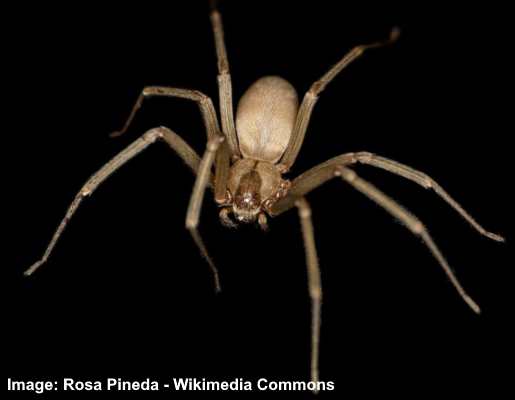
The brown recluse is a venomous spider found in Florida with light to dark brown body and long legs
The brown recluse is a venomous Florida spider with a small tan to reddish-brown body, long legs, and an identifiable dark violin shape on its cephalothorax. This species of brown spider measures 0.25” to 0.5” (6 – 12 mm) long. Brown recluse spiders are identified by the fact they have six eyes rather than the distinctive eye pattern of most spiders.
Brown recluses are not native to Florida. However, they are now relatively common and can be found hiding in dark places like boxes, attics, closets, and clothing. As their name suggests, the brown spiders are reclusive and are rarely seen scurrying across floors.
Florida Spider Identification: Most brown recluse spiders have an identifiable violin-like marking on their head, light to dark brown body, and long tan legs. Brown recluse spiders have unique eye patterning — six eyes arranged in pairs.
Brown Widow Spider (Latrodectus geometricus)
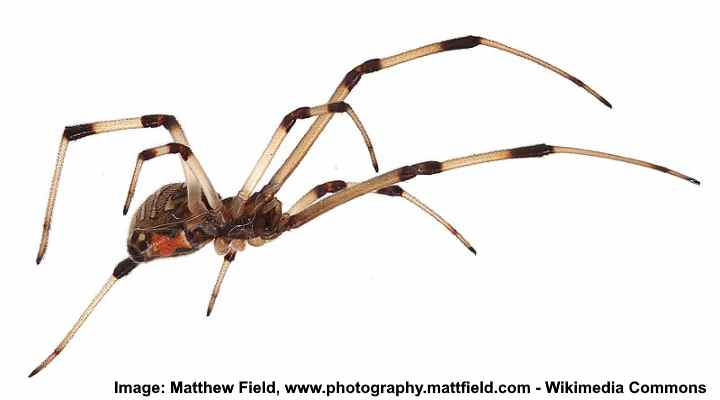
The brown widow spider has a dark striped back and dark orange hourglass marking on its underside
Although not native to Florida, the brown widow spider is commonly found in buildings south of Orlando. The brown spider is identified by black and pale brown geometric patterns on its body, striped legs, and a characteristic orange hourglass marking on its brown-colored abdomen. Brown widows measure 0.47” – 0.6” (12 – 16 mm) long.
Brown widows are typically found around buildings in warm, humid regions. This is one reason the non-native spider thrives in southern Florida. The web-spinning spiders are found in garages, closets, attics, and under outdoor furniture. Although they have a nasty venomous bite, they are not as dangerous as the native southern black widow.
Florida Spider Identification: Brown widow spiders have identifiable white and black striped legs, a bulbous dark brown abdomen, and a pale orange hourglass abdominal marking. The brown widow looks like an immature black widow, making it hard to tell them apart.
Domestic House Spider (Tegenaria domestica)
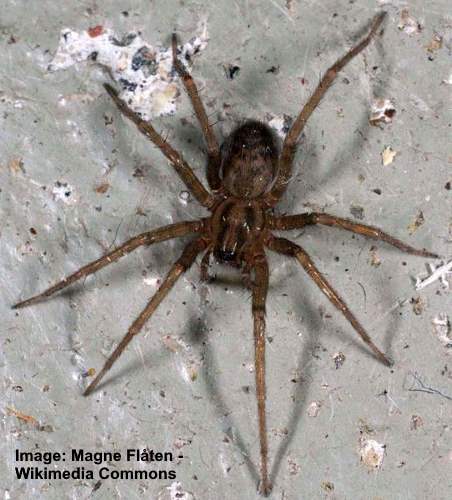
The domestic house spider is commonly found in Florida and has two black stripes on the front part of its body
The domestic house spider is common in Florida homes, lurking behind baseboards, furniture, and in dark crevices. The brown Florida spider has a brown body with dark patterns along its elongated abdomen and striped legs. The domestic house spider measures 0.24” to 0.47” (6 – 12 mm).
Although brown domestic house spiders look menacing, they are relatively harmless. They may bite when threatened, but their bite is usually painless and doesn’t cause any problems.
Florida Spider Identification: Domestic house spiders have mottled brown and beige abdomen, two dark stripes on their cephalothorax and long spiny legs.
Southern House Spider (Kukulcania hibernalis)
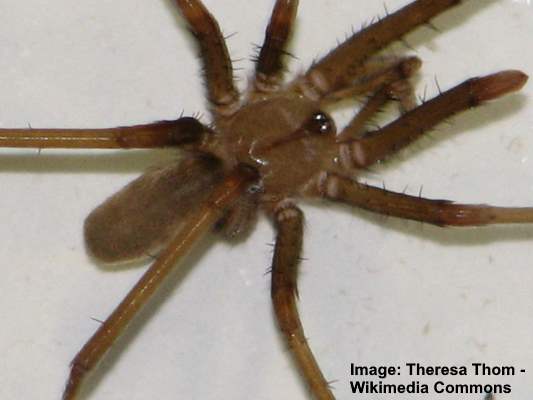
The large southern house spider is identified by its brown body and black hairs and is native to Florida
The southern house spider is native to Florida. The brown spider is identified by its slender brown elongated oval body covered in velvety fine hairs and brown legs with black spines. Adult female house spiders may have a more bulbous abdomen than males. These huge brown Florida spiders can grow up to 2” (5 cm) long.
Southern house spiders are commonly mistaken for the brown recluse. The difference between the two spider species is that southern house spiders are much larger and lack distinctive markings on their abdomen. In addition, this spider species is relatively harmless and doesn’t bite humans.
Florida Spider Identification: The southern house spider is identified by its dark brown body and large size.
Huntsman Spiders (Sparassidae)
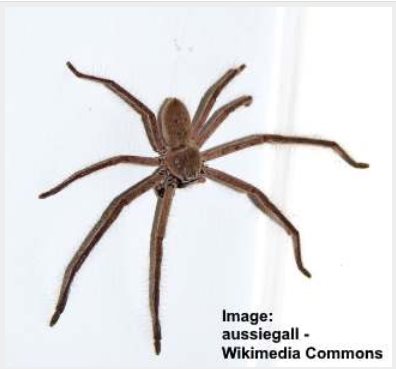
Huntsman is a group of spiders that include many species and they are large spiders with long legs
Huntsman spiders are a group of large tan-colored spiders with large crab-like legs. In Florida, it is easy to mistake huntsman spiders for pale brown tarantulas. However, the large spiders are brown or gray and often have reddish patches around their mouthparts. Huntsman spiders grow to around 1” (25 mm) with a leg span of up to 6” (150 mm).
A feature of the huntsman spider is its flattened, rounded cephalothorax. In the warm climates of Florida, huntsman spiders are commonly found in the wild and are common in avocado groves. The spider is found under furniture, in closets, garages, and behind wall hangings in colder weather.
Florida Spider Identification: Huntsman spiders have an identifiable shape with their round cephalothorax, small brown furry bodies, and huge brown legs with black spines.
Crab Spider (Thomisidae)
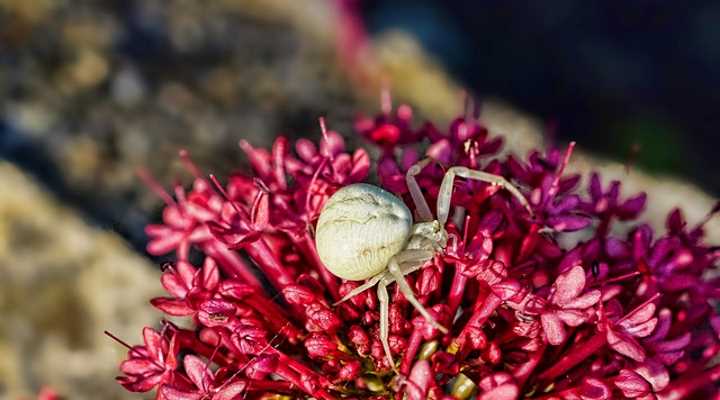
The goldenrod crab spider is identified by its large round white body, although it can turn yellow for camouflage
Many crab spiders in Florida are types of tiny white spiders with large bulbous bodies, small heads, and eight translucent pale greenish legs. A common species is the goldenrod crab spider (Misumena vatia) that measures up to 0.4” (10 mm) long. The unusual white spider looks like it’s carrying a button mushroom on its back.
You will often find crab spiders on milkweed, buttercup, red clover, and goldenrod flowers in Florida. An interesting characteristic is that the spider changes color depending on the flowers it feeds on. So, these could also be yellow spiders in Florida gardens.
Florida Spider Identification: Crab spiders are easy to identify because of their sizable egg-shaped abdomens, translucent legs, and ability to walk sideways and forward.
Common House Spider (Parasteatoda tepidariorum)
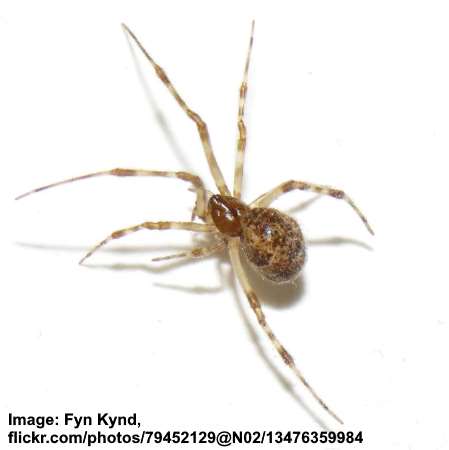
The tiny common house spider has mottled brown patterns on its body
Also called the American house spider, this common brown or black spider has an identifiable bulbous body with mottled patterning. The tiny brown spiders are not dangerous to humans, but they are so small that they are hard to spot — they measure less than 0.24” (6 mm) long.
American house spiders are not aggressive and won’t attack humans. However, they will sometimes bite if they feel threatened. These tiny brown spiders are also classified as cobweb spiders, and they use intricate webs to catch flies, ants, mosquitos, and wasps.
Florida Spider Identification: The American house spider has a shiny tan and brown bulbous body with mottled patterning.
Spiny Orb-Weaver (Gasteracantha cancriformis)

The spiny orb-weaver is a red, black and white spider with a unique shape
The spiny orb-weaver is easily recognizable in Florida gardens with its white oval body, black markings, and spiky red spines. This white spider with black spots has an abdomen broader than long. The small Florida spider measures under 0.35” (9 mm) long and 0.5” (13 mm) wide.
Spiny orb-weaving spiders are often called crab spiders due to their crab-like appearance. You will find them in citrus groves, shrubby gardens, and woodlands in Florida. There is nothing to worry about if you see this unusual white spider. It is not dangerous, and it feeds on insects that could harm your ornamental shrubs.
Florida Spider Identification: A spiny orb-weaver spider has an identifiable white oval body with black blotches and distinctive red spines.
Golden Silk Orb-Weaver (Trichonephila clavipes)
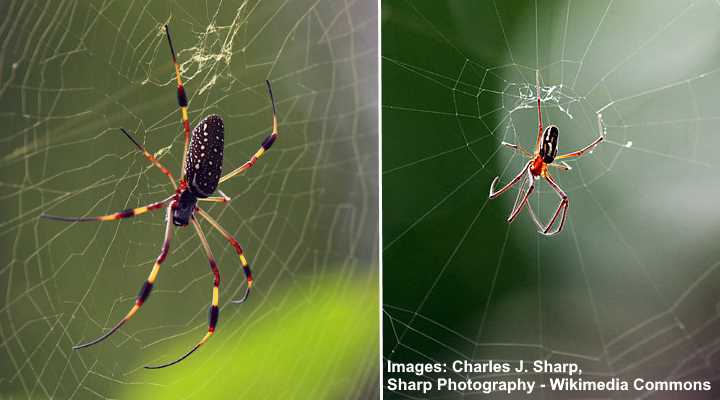
Golden silk orb-weaver female (left) and male (right)
Also called the banana spider, the golden silk spider is common in many southern US states, including Florida. An identifying feature of this sizable colorful spider is a distinctive reddish-brown or yellow coloring. Pictures of this garden spider show it has an elongated black body with white spots. The adult spider can measure between 0.94” and 1.6” (24 – 40 mm).
Banana spiders are commonly found in Florida gardens during nighttime and rarely venture indoors. The colorful spiders spin distinctive, yellow-colored webs to catch their prey. By some estimates, they are the largest orb-weaver spiders native to Florida.
Florida Spider Identification: Golden silk orb-weaver spiders have colorful black, yellow, and red striped legs and a large black body covered in white markings.
Jumping Spiders (Salticidae)
The gray wall jumper and pantropical jumper are two species of jumping spiders native to Florida. The black and white hairy spiders have a rounded cephalothorax and oval abdomen. They are also identified by their fuzzy black and white striped legs. Florida jumping spiders measure up to 0.47” (12 mm) long.
The gray wall jumper (Menemerus bivittatus) is commonly found in buildings and hunting prey at night. They are also classed as beneficial insects because the spiders feed on mosquitoes, flies, and other household pests. Additionally, they don’t create messy cobwebs in homes.
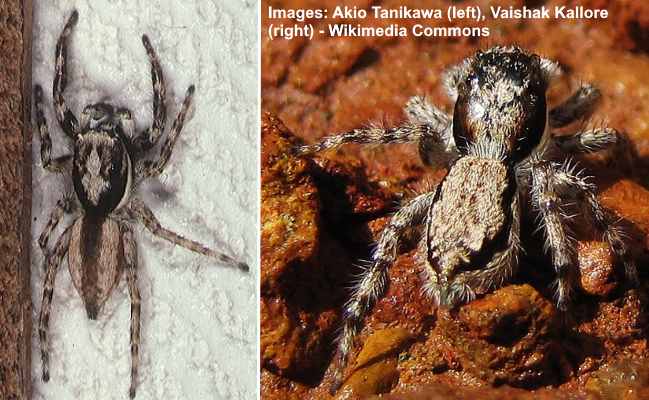
Gray wall spider male (left) and female (right)
The pantropical jumper (Plexippus paykulli) is identified as a black spider with a distinctive white stripe down its head and abdomen. However, the adult female jumper has duller markings that are a more gray color than white.
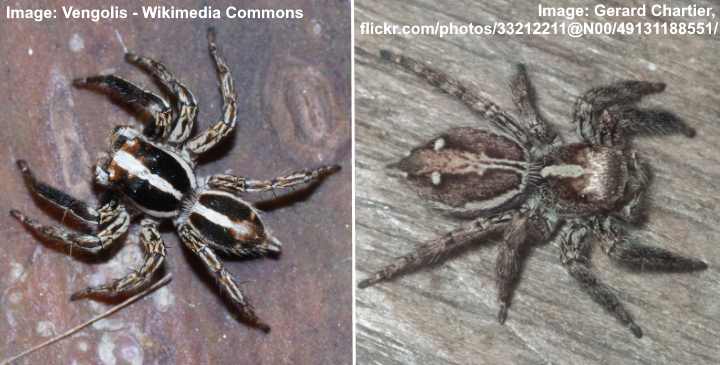
The pantropical jumper male (left) and female (right)
Florida Spider Identification: Jumping spiders in Florida are identified by their hairy bodies, black and white colors, and ability to jump. The good news is that jumping spiders are harmless to humans.
Southern Black Widow Spider (Latrodectus mactans)
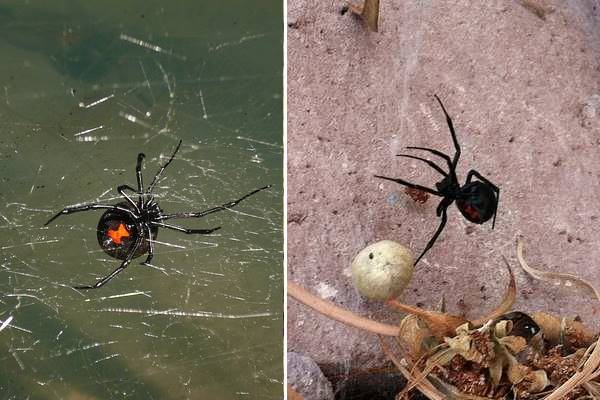
The southern black widow spider has a black body with a distinctive red hourglass marking on its underside belly
The most common venomous black and red spider found in Florida is the southern black widow. The black spider has the characteristic two red triangle markings creating an hourglass shape. In addition, a southern black widow is identified by having a round, bulbous shiny black body, long forelegs, and a relatively small head.
Southern black widows measure 0.3” to 0.5” (8 – 13 mm) in length. The dangerous spiders inflict a nasty bite resulting in pain, redness, swelling, and muscular cramps. If you suspect a black widow has bitten you, it’s vital to seek medical attention as soon as possible.
Florida Spider Identification: A southern black widow spider has an easily recognizable vibrant red hourglass marking contrasting with its glossy black ball-like body.
Northern Black Widow (Latrodectus variolus)
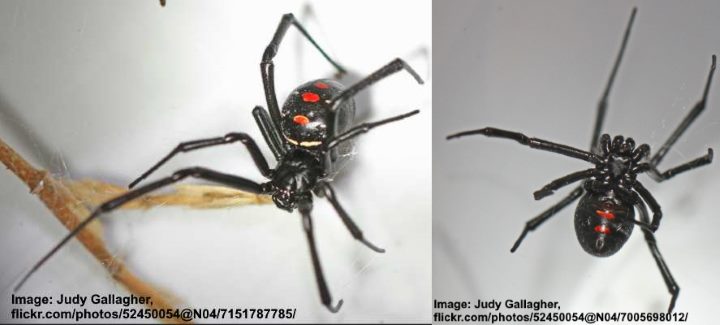
The northern black widow spider is identified by its black shiny body and red or dark orange dots on the back. The underside of northern black widow spider has two red dots
The northern black widow spider is a venomous spider with a bulbous black abdomen with three or more dark orange or red dots on its back. The venomous black spider also has relatively long black legs that sometimes have dark orange bands on them. Female northern black widows grow up to 0.5” (13 mm) with a leg span of 1.5” (38 mm).
In Florida, the northern black widow is less common. However, it can still be found in buildings north of Orlando and up to southern Canada. The difference between the southern and northern black widows is the three dots and stripes on the northern widow.
Florida Spider Identification: The northern black widow is a venomous black spider with three red markings on its abdomen. Juvenile northern black widows also have recognizable white stripes on their abdomens
Red Widow Spider (Latrodectus bishopi)

The red widow spider can be identified by its orange head and legs, with red spotted black abdomen
The red widow spider is a native Florida spider with a bulbous black abdomen, red dots on its body, and orangey-red legs and head. The red widow lacks the characteristic hourglass marking typical of black widows. Instead, you can identify this venomous spider by red spots surrounded by yellow rings.
The red widow spider is found in Florida’s sand dunes where sand pines grow. The red and black spiders measure up to 0.5” (13 mm) long. Unlike the southern black widow, it’s rare for a red widow to bite humans. This is probably because it is always found far from human populations.
Florida Spider Identification: The red widow spider is an orange and black spider with red and white dots on a rounded, bulging black abdomen.
Black and Yellow Garden Spider (Argiope aurantia)
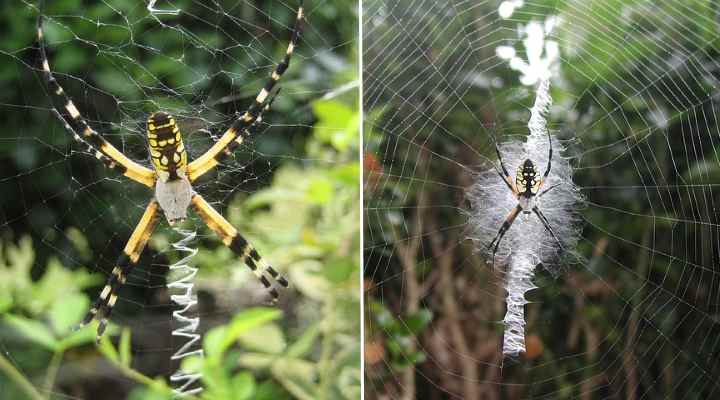
The yellow garden spider is a large spider with long legs that can bite when threatened
The distinctive black and yellow garden spider is common in Florida gardens. The yellow spider is identified by its pointed oval black abdomen with striking yellow markings. Although this spider is relatively large with its long black and yellow striped legs, it is harmless to humans. The garden spider measures up to 1.1” (28 mm) long.
You will often find yellow garden spiders sitting in the middle of elaborate webs in southern gardens. The spider webs have a recognizable zig-zag pattern. A painful bite by a yellow garden spider is comparable to a bee sting.
Florida Spider Identification: The black and yellow garden spider has an identifiable oval body with black and yellow markings and a grayish-white head.
Daddy Long Legs (Pholcus phalangioides)
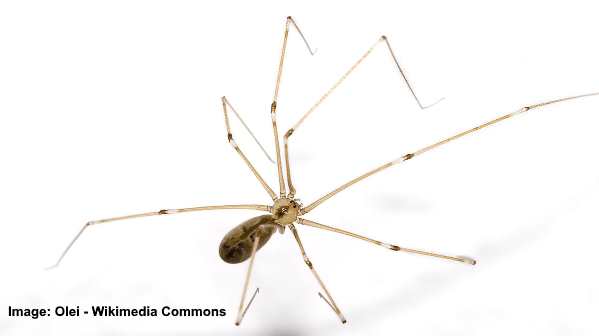
Daddy long legs are common house spiders in Florida and like to live in dark places
Daddy long-legs spiders are harmless common house spiders in Florida, characterized by their long spindly legs and slender brown bodies. Also called skull spiders or long-bodied cellar spiders, the yellowish-brown spiders have legs six times longer than their bodies. The small-bodied light brown spiders grow up to 0.4” (10 mm) long, but their enormous leg span makes them appear larger.
Other spider species also have the name daddy long-legs, such as the arachnid group of harvestmen (Opiliones).
Florida Spider Identification: Daddy long legs spiders have long pale-brown legs, a darker tear-shaped abdomen, and cephalothorax in the shape of a human skull.
Related articles:
